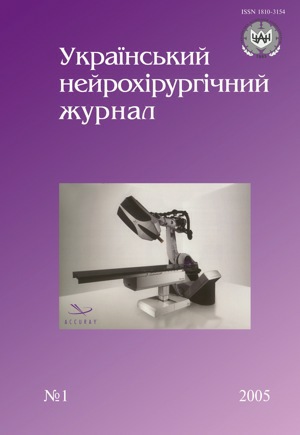Neuropsychological descriptions of cronical neuropathical pain syndrome
DOI:
https://doi.org/10.25305/unj.135536Keywords:
pain syndrome, a chronic pain syndrome, rating scales measuring pain, qualitative, quantitative, temporal parameters of painAbstract
Neuropsychological descriptions of cronical neuropathical pain syndrome were studied. The number of tests for pain characteristics research was used, including the scale of visual analogues, verbal descriptions of the pain feelings, and also qualitative and quantitative changes of pain syndrome, in different time frames. The obtained data allowed us to visualise the pain picture and build the three-dimensional model of different types of pain syndromes.
References
Вейн А.М., Вознесенская Т.Г., Данилов А.Б. и др. Болевые синдромы в неврологической практике. — М.: МЕДпресс, 1999. — 372 с.
Гехт Б.М., Касаткина Л.Ф., Самойлов М.И. и др. Электромиография в диагностике нервно-мышечных заболеваний. — Таганрог: Изд-во ТРТУ. — 1997. — 370 с.
Гнездилов А.В., Сыровегин А.В., Кукушкин М.Л. и соавт. Ноцицептивные рефлекторные реакции мышц верхних конечностей у человека — Бюл. эксперим. биол. и мед. — 1998. — Т.126. — С.278–282.
Ратанова Т.А. Субъективное шкалирование и объективные физиологические реакции человека. — М.: Педагогика, 1990. — С.37–39.
Сапон Н.А., Чеботарева Л.Л. Использование инструментальных методов исследования для оценки нейрофизиологических коррелятов боли // Укр. нейрохір. журн. — 2004. — №4. — С.69–75.
Чеботарьова Л.Л. Комплексна діагностика травматичних уражень плечового сплетення і периферичних нервів та контроль відновлення їх функцій: Автореф. дис. ... д-ра мед. наук. — К., 1998. — 32 с.
Шухов В.С. Значение исследования боли в объективизации клинического состояния больных, перенесших оперативное вмешательство на позвоночнике // Журн. невропатол. и психиатр. — 1991. — Т.91, №4. — С.22–25.
Шухов В.С. Роль альгологического тестирования в клиническом исследовании пациентов с люмбальгией // Периферическая нервная система / Под ред. И.И.Антонова. — Минск: Наука и техника, 1989. — Вып.12. — С.114–117.
Шухов В.С. Суставные боли: Введение в мануальную медицину // Твое здоровье. — М.: Знание, 1992. — Вып.4 — 112 с.
Corson J.A., Schneider M.J. The Dartmouth Pain Questionnaire an Adjunct to the McGill Pain Questionnaire // I bid. — 1984. — V.19, N1. — P.59–69.
Daut R.L., Cleeland C.S., Flanery R.C. Developmend of the Wisconsin Brif Pain Questionnaire to assess pain in cancer and other diseases // Pain. — 1983. — V.17, N2. — P.197–210.
Frederickson L.W., Lynd R.S., Ross J. Methodology in the mea-surement of pain // I bid. — 1978. — V.9, N5. — P.486–488.
Hadjipaviou A., Gracovetsky S., Benhaim A., Conway L. Use of artificial intelligence in the diagnosis of low back pain and sciatica // ISSLS Abstr., Rome, 1987. — P.52.
Jaded A.R., Hillier T.L.B. Measuring clinical pain: do we need more tools? // 8-th World Congr. on Pain: Abstr. — Vancouver, 1996. — P.304.
Larbig W., Gerber W.-D. Advances in chronic pain assessment in research // 8-th World Cong.on Pain: Abstr. — Vancouver, 1996. — P.205.
Melzack R. The short-form McGill Pain Questionnaire // Pain. — 1987. — V.30, N2. — P.191–197.
Melzack R., Torgerson W.S. On the language of pain // Anest. — 1971. — V.34, N1. — P.50–59.
Scott J., Huckisson E.C. Grapchic representation of pain // Pain. — 1976. — V.2, N2. — P.175–184.
Turk D.C., Wack J.T., Kerns R.D. An empirical examination of the “pain behavior” construct // J. Behav. Med. — 1985. — V.9, N2. — P.119–130.
Tursky B., Jammer L.D., Friedman R. The pain perception profile: a psychophysical approach to the assessment of pain report // Behav. Ther. — 1982. — V.13., N3. — P.376–394.
Downloads
How to Cite
Issue
Section
License
Copyright (c) 2005 N. A. Sapon

This work is licensed under a Creative Commons Attribution 4.0 International License.
Ukrainian Neurosurgical Journal abides by the CREATIVE COMMONS copyright rights and permissions for open access journals.
Authors, who are published in this Journal, agree to the following conditions:
1. The authors reserve the right to authorship of the work and pass the first publication right of this work to the Journal under the terms of Creative Commons Attribution License, which allows others to freely distribute the published research with the obligatory reference to the authors of the original work and the first publication of the work in this Journal.
2. The authors have the right to conclude separate supplement agreements that relate to non-exclusive work distribution in the form of which it has been published by the Journal (for example, to upload the work to the online storage of the Journal or publish it as part of a monograph), provided that the reference to the first publication of the work in this Journal is included.









